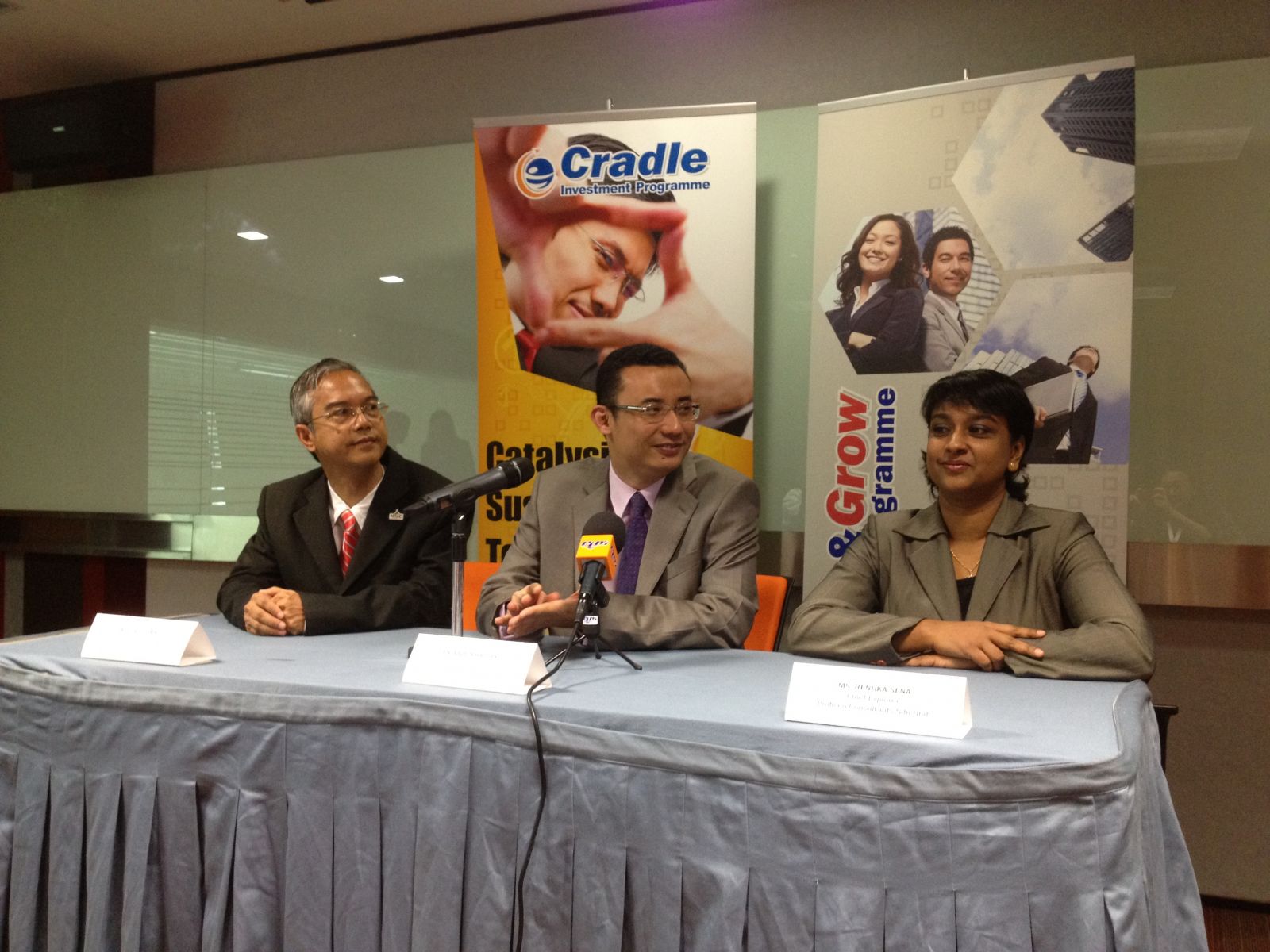Cradle’s CGP gets green light for second year
By Gabey Goh November 23, 2012
- Inaugural CGP had 150 companies in varying lifecycle stages undergoing its program
- Additional RM4million has been allocated by the Government for a second year

THE Coach and Grow Program (CGP), an entrepreneur training program launched in July last year, celebrated its inaugural year on Nov 22 with a convocation ceremony for entrepreneurs who successfully completed the program.
The CGP is a market-driven program that brings together key players in the entrepreneurial ecosystem to coach existing entrepreneurs to overcome business challenges and grow their businesses to greater heights.
This is achieved by looking into the key reasons they fail to grow or scale during crucial stages of their growth life cycle, via coaching, networking and showcase events.
The three-stage CGP program targeted participants from the pre-seed, growth (8 months to 2 years post-development or within 6 months of commercialization), global (at least 12 months post-commercialization) and pre-IPO levels.
About 323 companies applied for the CGP out of which 150 were accepted after passing the selection process.
Cradle Fund chief executive officer Nazrin Hassan said that when the CGP was first announced, the decision to have the program led by the private sector was a pivotal move in the long-term outlook for the technopreneur ecosystem.
“A year later, we have seen ample evidence to support our conviction that the CGP is a crucial link in the government-private sector partnership to develop the technopreneur ecosystem, even as we are further convinced that future efforts to help entrepreneurs overcome barriers should be the domain of the private sector in tandem with the maturing of the Malaysian technopreneur ecosystem,” he said.
Nazrin said that more than 30% of the entrepreneurs have obtained investors as mentors, with several others in various stages of discussions with angel investors, venture capitalists and other strategic investors.
He also said that the CGP trained 570 entrepreneurs during Stage I and coached a total of 420 entrepreneurs during Stage II.
When it was first launched, the CGP targeted to train 500 entrepreneurs during Stage I, from which 300 entrepreneurs would be selected to receive coaching during Stage II.
In addition, 60% of Growth Stage companies increased their revenue by at least 20% with 30% of companies in the group actually achieving more than a 100% growth in sales from previous years, he claimed.
Over 80% of companies in the global stage programs not only identified new markets but commenced market entry activities.
These results exceeded the KPIs for Growth and Global stage entrepreneurs, which aimed to increase business revenue by 20% and to identify new markets.
The convocation event was officiated by Dato’ Sri Dr Mohd Irwan Serigar Abdullah, secretary general for the Treasury at the Ministry of Finance, and saw the announcement of the top 10% of participants consisting of 15 companies and the announcement of the top 30% of participants.
Dr Mohd Irwan also announced that support for the CPG will be continued with the allocation of another RM4 million (US$1.3 million) on top of the initial RM5 million (US$1.6 million) which was provided to launch the initiative.
“Our additional goal to create a pipeline of high quality entrepreneurs has also been successful, and we have shown regional and global investors that there are good quality deal flows in Malaysia,” claimed Nazrin.
Taking culture into account

“In short, the CGP intended to teach our young Malaysian innovation ecosystem how to act like a supportive ecosystem – which has as its focal point, the entrepreneur and his business,” he said.
Nazrin shared that some of the venture capitalists pulled into the program realized that there are good deal flows if you are a part of creating those deal flows, in contrast to the traditional strategy where the venture capitalist would wait for someone to pitch to them and after 15 minutes conclude that there are no good deals.
“The CGP is very much molded in an Asian way, and we’re saying don’t do things the Western way, come in and get to know and value add to the entrepreneurs. Get to know them as people and build the relationship because investment is about relationships,” he said.
“Prior to this, where we’ve used the pitch formula, it’s a distanced way of trying to raise funds and we don’t raise funds like that, we have chats at the kopitiam, that’s our culture,” he added.
Nazrin said that the Silicon Valley approach doesn’t really work for Malaysia.“In the United States, people go through Show and Tells since year one at school but over here you have university students who can’t pitch to save their lives!”
He added that it was a case of different environments in terms of cultural expression environments, hence the CPG’s conscious effort to adapt and become a more Asian-friendly program.
“In this environment, where all parties collaborate to value add to the entrepreneur, we actually get more out of him and ecosystem as well,” he said.
Lessons learnt and what’s next
Renuka Sena (above pic, right), chief explorer at Proficeo Consultants, CGP’s program manager, said that companies who were high achievers within the program all shared the same trait.
“It all boils down to self-motivation. As they say, you can lead a horse to water but you can’t make him drink. So those startups who were proactive and engaged with everything the program had the offer were the ones who also reported the most growth,” she said.
When CGP being granted the green light (and funds) to continue, Renuka said lessons learnt from this inaugural year will be applied to the program with the next intake.
“There were a lot of lessons learnt in how we conducted the coaching and one of which was, more time needs to be given to the one-on-one sessions,” she said.
“We expected most of the entrepreneurs to already have resources be it money or skilled personnel but they didn’t so coaches needed to spend a lot more time with them than initially anticipated so we changed the structure around to ensure that they get more time,” she added.
In addition, a unique component of the program will be the continued relationship the CGP will have with the top 45 companies.
Typically after a training program has concluded, there is no substantive follow-up. However, Renuka said, it is imperative that the seeds sown with the various stakeholders in the ecosystem continue to be nurtured.
She said that the universities have been a tremendous source of support by providing the resources of their students and faculties in helping entrepreneurs solve various business challenges that they face, and this engagement and relationship will definitely be scaled up.
Over the next few months, the team will be organizing entrepreneur showcases with all the key agencies for the top 45 CGP companies to present their achievements, plans and needs.
"Following this presentation, we will then continue to work with the agencies to provide the support and facilities required by the entrepreneurs," she said.
“These guys will continue to be groomed because there is no way that they can actually achieve something in only 12 months and they’re just starting to get there and reach their tipping point. We cannot drop them now, especially if we really want to see success stories coming out of the country.” she said.
The positive response and results of the CGP for its first year has certainly erased the initial hesitations and reluctance Nazrin had about Cradle taking the lead during the CGP’s early stages, he said.
During a Budget consultation session for Budget 2011, which was chaired by Dr Mohd Irwan, he had asked for new innovative ideas which the Government could implement in the approaching Budget, and Nazrin casually mentioned that some private sector parties were coming up with the CGP and explained the concept and the purpose behind it.
Dr Mohd Irwan loved the idea and mentioned that it was very much aligned with the Prime Minister’s and Government’s focus on improving the quality of human capital, including entrepreneurs. He not only wanted the program to be done, he also wanted it to be done on a larger scale.
Nazrin shared that he initially hesitated and declined, as Cradle is purely a funding agency and the team had no domain in formally coaching entrepreneurs, much less in leading a big program of this size.
“Finally, I was persuaded for Cradle to take up the role when Dato’ Sri (Dr Mohd) Irwan said: ‘If I pass this to another agency and they mess it up, then it’s your fault.’ That was the clincher.”
The CGP's top 45 technopreneurs are featured on the Founders Asia, which is a platform set up to showcase top notch entrepreneurs for global investor interest.
Cradle has also issued an invitation to all coaches, mentors and advisors to register their interest in participating here. Entrepreneurs who want to scale their business to the next level are also invited to register their interest for coaching here.
For more information on the CGP, click here.
Related Story:
Malaysia's start-up scene needs to break out of stealth mode


